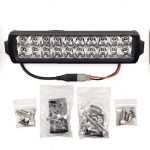We have discussed in several articles at lawneq how many household items can be used to enhance or protect plants in your garden. These items include vinegar, eggshells, tea bags, cooking water, and more. Your cupboard is truly a treasure trove of things that can help plants in your garden thrive.
One more to add to the list is aluminum foil. Commonly used to line broilers when making a steak or cover food for storage in a freezer, aluminum foil can also be used to protect plants from insects, protect trees from rodents and other pests, incubate seedlings, or to serve as a surface of a sun box to host houseplants.
Aluminum Foil As Protection Against Insects And Other Critters
The larvae of cutworms live in garden soil and move around at night. As they travel they sheer off stems of plants. Considered more a threat at the beginning of the growing season, the larvae can cause damage later on in the growing season. They have smooth skin, grow to a length of about 2-inches and curl into a C-shape when poked with a finger or stick. In addition, Southern blight, a fungus that attacks the stems of tomatoes, peppers and eggplants live in the topsoil. Signs of the blight appear as wilted and white plants and thread-like hyphae on plant stems at the soil level. Aluminum foil is an ideal material for forming collars around the stems of plants preventing the cutworm larvae and Southern blight from causing any damage to your plants.

Since the larvae and blight live in the soil, the aluminum foil should be installed around the stem of plants above and below the soil. There are five steps to creating an aluminum foil protective collar.
The items you will need for the project are:
- Aluminum foil
- Scissors
- Trowel
If you don’t have aluminum foil, lightweight cardboard will suffice.
Before encasing the stems of your plants, rummage around the garden to locate and remove legume type plants. These plants host cutworm.
Creating the collars is quite simple.
- Use the scissors to cut a 6-inch by 4-inch piece of aluminum foil.
- Use the trowel to dig away soil from the base of the plant. Take caution not to damage roots.
- Wrap the aluminum foil loosely around the stem of the plant. Make sure that 3-inches of foil is below the soil line and 3-inches above it.
- Return soil around the base of the plant covering the lower part of the foil.
- Check the collars periodically during the growing season to be certain they are not choking the plant. If they are, loosen them.
Once the foil collar is on the plant, work the soil around it carefully so as not to dig into, get under or tear the foil. Be aware that Southern stem blight can enter the collar through holes in the foil.
Aluminum Foil In Mulch
Aluminum foil can also assist mulch as a guard against invading insects.
Items you will need include:
- Roll of aluminum foil
- Ruler
- Mulch
- Wheelbarrow
- Hoe or trowel
The task of mixing the foil and mulch and laying the substance can be performed in five steps.
- Tear off several sheets from the roll of aluminum foil. The number depends on the square footage of the planting beds you are mulching.
- Rip the foil sheets into a half-inch to 1-inch long sheets. There should be a few strips of foil for every few feet of mulch.
- Put the mulch and the foil strips into a wheelbarrow. Use a hoe or trowel to mix the foil into the mulch.
- Scatter the mulch into the garden as you mingle the strips of foil into the mulch. Evenly scatter the pieces throughout the garden.
- If the mulch has been laid, add the foil strips to it. Use a garden hoe to mix the foil into the previously laid mulch. Be sure to scatter the foil thoroughly among the mulch.
Aluminum Foil Protects Trees From Rodents And Pests
Aluminum foil is a great guard to protect your trees against rodents and pests during the winter.

Items you will need for this project include:
- Roll of aluminum foil
- Tape measure
This project can be performed in just four easy steps.
- Use the tape measure to measure the circumference and height of the base of the trunk. The measurement should begin 2-feet to 3-feet above the ground.
- Tear sheets of foil based on your measurements. Double each measurement because you will be applying two layers of foil around the trunk.
- Wrap the base of the trunk with the first sheet of foil. Be sure to press the foil against the tree trunk to assure a connection to the wood. Work your way upward as high as you plan to wrap the tree.
- Add a second layer of foil starting from the base of the tree.
Using Aluminum Foil To Incubate Seedlings
You can use aluminum foil to line a shoebox to create an incubator for seedlings.

Items you will need include:
- Roll of aluminum foil
- Shoebox
- Ruler
- Scissors
- Knife or Pin
- Potting Soil
- Seeds
- Glue
This project can be completed in nine simple steps.
- Choose a shoebox that is sturdy enough to hold moist soil and growing plants.
- Measure the base and sides of the box and allow for two extra inches.
- Cut the aluminum foil to the measured size and base of the shoebox.
- Glue the foil to the sides and bottom of the shoebox.
- Poke small drainage holes through the bottom of the shoebox and foil.
- Fill half of the box with potting soil
- Add seeds. Be sure to embed the seeds snuggly into the soil.
- Moisten the soil with water.
- Place shoebox near a sunny window to allow light to reflect off the aluminum foil onto the seedbed.
(Source: sfgate.com and Wikihow.com)






